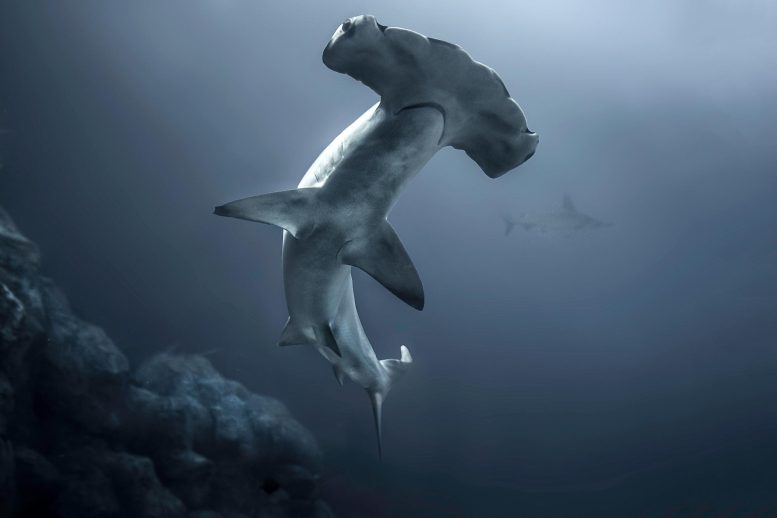
Hammerhead sharks use a “breath-holding” technique to maintain body temperature while hunting in deep, cold waters, according to a new study. This previously unobserved phenomenon is similar to thermoregulation strategies employed by marine mammals and may be common among other deep-diving sharks and fishes. The study used remote biologgers implanted in adult sharks to measure depth, water temperature, activity rates, body movements, and internal body temperature. The researchers found that the sharks maintained elevated body temperatures during the deepest part of each dive by closing their mouths and/or gill slits, reducing the flow of cold water across their gills. Further research is needed to confirm this thermoregulation strategy, but it could be widespread among other epipelagic and teleost fishes.
Hammerhead sharks “hold their breath” to maintain body temperature while hunting in cold, deep waters, a strategy that may be common among other deep-diving marine creatures.
Hammerhead sharks “hold their breath” to maintain body temperature as they hunt in deep, cold waters, according to a new study. The previously unobserved and unexpected phenomenon, which has broad similarities to breath-holding thermoregulation strategies employed by marine mammals, may be widespread among other deep-diving sharks and fishes.
Like most fishes, sharks are fully ectothermic, and their body temperatures are largely regulated by their immediate environment. This can present a physiological challenge for large predatory fish who must maintain certain body temperatures to function yet venture into colder, deeper waters to find prey.
For example, scalloped hammerhead sharks (Sphyrna lewini), which occupy warm surface waters in temperate and tropical coastal regions, routinely make repeated deep dives to depths exceeding 800 meters where water temperatures can get as low as 4 degrees Celsius to hunt for prey. Given their lack of morphological and vascular adaptations to actively conserve body heat, it’s unknown how these sharks can maintain body temperature during deep, frigid dives.
To explore this mystery, Mark Royer and colleagues developed state-of-the-art remote biologgers, implanted internally in adult sharks, that measured depth, ambient water temperature, activity rates, body movements, and internal body temperature. The authors found that the sharks maintained an elevated body temperature (up to 20 degrees Celsius above ambient temperatures) throughout the deepest portion of each dive and only rapidly began to lose heat on their return to the surface.
Royer et al. suggest that the sharks maintain their body heat by effectively “holding their breath” while diving. By closing their mouths and/or gill slits tightly to reduce the flow of cold water across the gills, the sharks could minimize the loss of body heat due to “breathing” cold water. The rapid loss of body heat during their ascent to warmer waters likely reflects the reopening of gill slits and convective heat transfer.
The authors note that further research is needed to confirm the thermoregulation strategy.
“Given the effectiveness of breath holding and the strong selective forces that shape behavioral and physiological thermoregulation, this strategy could be widespread among other epipelagic and teleost fishes,” write Mark Meekan and Adrian Gleiss in a related Perspective.
Reference: “‘Breath holding’ as a thermoregulation strategy in the scalloped hammerhead” by Mark Royer, Carl Meyer, John Royer, Kelsey Maloney, Edward Cardona, Chloé Blandino, Guilherme Fernandes da Silva, Kate Whittingham and Kim N. Holland 11 May 2023, Science.
DOI: 10.1126/science.add4445









Be the first to comment on "Cold-Blooded Secret: Hammerhead Sharks Hold Their Breath To Stay Warm As They Hunt"